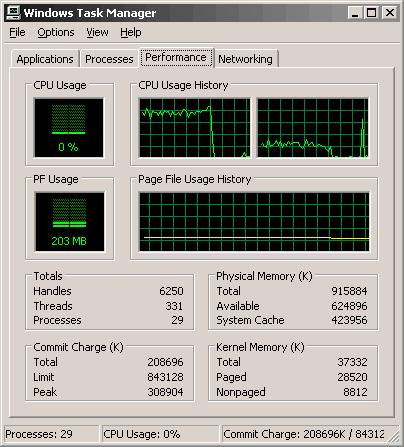Indeed, the load is not distributed evenly between the cores. What concerns the ranks of our chipsets, AMD 690G leads again. But this time the gap is minimal. By the way, Cool'n'Quiet increased the average CPU load only a little in this and other tests, which decoded "heavy" recordings. The driver is indeed responsive to the increasing load and raises frequency in time. There are no side effects or skipped frames in the power saving mode.
The next file is a 1080p video fragment in H.264 format. It's a heavy format indeed. VLC copes with this task in software mode only owing to its excellent optimization and even distribution of the load between CPU cores.
What concerns hardware-assisted modes, we can note a relatively low result of AMD 690G, which does not agree well with other test results. However, solution to this very problem has been already found. We only have to wait for proper BIOS updates from motherboard manufacturers. To all appearances, performance drops here because of non-optimal settings, which cause memory latencies (when a chipset accesses a memory controller in a processor). As a result, the powerful graphics core remains idle. Other tests probably took advantage of the computing capacity of the graphics core.
Drawing a bottom line under performance tests, we can note that the graphics cores in these chipsets are powerful enough to cope with decoding even heavy formats. There is practically no need in buying a graphics card for this purpose (you'd better invest in your processor, to free a computer for other tasks even when it decodes video in a "heavy" format). Moreover, the difference between integrated solutions and an entry-level graphics card in video decoding tests was noticeably smaller than in games. The integrated graphics core from AMD turned out even stronger in several tests than a graphics card.
Peripheral interfaces
When GeForce 7050 was launched, there were some rumors that USB support in this chipset was inferior to the modern standards, that its maximum read rate was limited. It's a good occasion to add tests of peripheral interfaces to our chipset test procedure.
However, these tests did not make a big stir. Even if the USB implementation in the GeForce 7050 is worse than its competitor, the difference is within several percents. We like the modern revision of SB600 south bridge in the AMD 690G chipset. The read rate from an MMC card demonstrated in this test corresponds to the maximum level among all previously reviewed chipsets.
Now let's have a look at theoretically possible SATA and PATA transfer rates. There is nothing to comment on here. Both interfaces offer redundant bandwidth with the existing devices. SATA devices may require higher bandwidths in future (but the standard will mostly likely be updated by this time), while new PATA hard drives are already extremely rare.
Conclusions
On the whole, the new chipset from NVIDIA produced a nice impression on us. Along with decent functionality and performance, we can mention its low heat release, just like in AMD 690G. Biostar engineers equipped the motherboard on GeForce 7050 with a larger heatsink than the model on AMD 690G. But we should keep in mind that the NVIDIA chipset consists of only one chip. So if we compare the total heat dissipation, they will most likely be on a par.
We come to the same conclusion, when we compare the chipsets by other criteria. Its higher total performance score in games is "compensated" by the defeat in video decoding tests. And what concerns functionality, differences between GeForce 7050 and AMD 690G are minimized, as if deliberately. Perhaps, it's convenient from a consumer's point of view. But it will hardly help NVIDIA promote the chipset. Motherboard design requires certain resources. And when it's ready, similar products from the same manufacturer start competing with each other. So the total number of sold motherboards (the most interesting parameter for a company) will not grow much. So why launch a motherboard on GeForce 7050 at all, if a similar product on the older AMD 690G chipset is already available?
Of course, manufacturers interested in providing a wide range of products for end users, like Biostar, will produce motherboards on both chipsets (in several bundles) specially for serious-minded readers, who seek solutions strictly for their tasks. And NVIDIA will have to find weightier arguments for the mass market.
However, the AMD64 platform has one advantage - it does not have a direct relation between CPU generations and chipsets. As a result, we can see the best chipsets of the previous generations used in modern motherboards. So, even if the main manufacturers don't launch motherboards on GeForce 7050 at once, this chipset may be used by many motherboards in future as the platform is updated.
We should also say a few words about GeForce 7025 and AMD 690V, which are almost identical in functionality. There is only a small difference - the NVIDIA chipset has the second graphics slot and supports DVI, while the AMD chipset preserves hardware-assisted decoding of HD Video and an integrated TV-Out. So they supplement rather than compete with each other.
Write a comment below. No registration needed!


